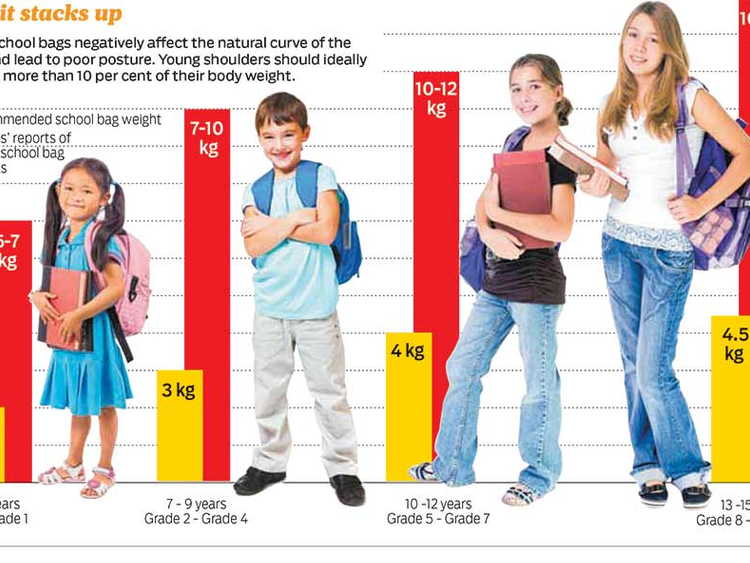Dubai: As children return to school, the issue of heavy bags raises its ugly head once again.
Until last year students in UAE were found to be carrying school bags that were 20 to 25 per cent of their body weight when the admissible limit is only 10 per cent of body weight.
Dr Yash Gulati, spine and total knee replacement specialist at RAK Hospital, told Gulf News: “Carrying schools bags more than 10 per cent of one’s body weight can cause muscle spasms around the back and neck. Children need help to have their backpacks hauled on their back and usually carry the weight on one side of their back. This tilted weight can cause a permanent tilted posture and although there is no evidence of permanent spine deformity, the weight does cause long-term aches, pains, fatigue and irritability which affects the student’s performance and can cause issues like lower back pain and spondylosis in the long term.”
Despite the initiation of e-learning and locker system in schools, children continue to carry bags that are very heavy. Some children prefer to carry trolley bags, but the trolley paraphernalia adds to the weight and while boarding and alighting from a school bus and climbing stairs to the classroom picking up the trolley bag is far more tedious than the regular backpack and proves counter- productive.
The school bag weight has been hotly debated by parent–teacher fora and yet no conclusive decision has been made.
On any given day, a child spends eight hours at school and at least 1.5 hours travelling to and from school. In these hours he is required to carry his bag for a total of 30 minutes or more. The bags contain at least five textbooks, three workbooks, five notebooks, one rough book, a school calendar, compass box and tiffin box.
If the child goes for tuitions after school, usually those books are also put into the school bag, adding to the weight. If one were to multiply that by 25 days and then by the number of years the student carries the bag, it adds up to several years of load carrying that can have a detrimental impact on the spine, particularly in the case of weak-bodied students.
Dr Sunjay Sureen, specialist orthopaedician at Prime Hospital, told Gulf News: “Normally if a child weighs 30kg, his school bag must not exceed 5kg. But when the parents come to me with their children complaining of head and neck pain, I have discovered these students to be carrying at least 10-12kg weight in their school bags. For children, especially in the 10 -1 4 years age group when the musculo-skeletal structure is still developing, this kind of weight can cause both short-term and long-term problems.”
In a 2006 study conducted by the College of Physiotherapy, Trinity College of Dublin, on the weight of school bags, researchers S. Dockrell, C. Kane and O. Keefe had mentioned that the school bag weight must not exceed 10 per cent of the body weight and had drawn up a body discomfort chart which ranged from plain fatigue to head and neck pain.
Dr Sureen cautioned: “Never ignore your child’s complaints of tiredness and fatigue. The general body discomfort of carrying heavy bags is usually manifested in the short term by these complaints. Our bodies are usually resilient and adapt to the discomfort. But that is not the case with all. Any child who has a predisposition to scoliosis [unnatural curvature of the spine] or is weak-built is likely to feel the pain and discomfort more sharply and, if left unattended, it could aggravate and impact the child’s performance at school.”
A joint action based on recommendations from school and suggestions from parents is required to address this issue and relieve children of this burden. Attempts to get a statement from any school representatives on the topic were not successful.
Parents speak
The weight of children school bags has always been a contentious issue. Though I am lucky as my daughter studies in GEMS Wellington Silicon Oasis, and the curriculum doesn’t require them to carry heavy textbooks to school every day, still there are days when the PE kit, the tiffin, the water bottle and the BYOD ‘e-learning gadgets’ make the bag a bit too heavy for the 9 year olds! I have tried wheeled strolleys to take the weight off her shoulders. But I had to revert to a backpack as students are encouraged to use the stairs in school (and rightly so) and it becomes impossible to drag the strolleys down the stairs.
Neha Kaul
Mother to a 9-year-old girl
Kuya Don Don Esmael, father of a 9-year-old boy
My son is in year 4 at a Dubai school and I often despair seeing him carrying a bag weighing 8kg when his weight is not more than 25kg. Although the school where he is studying has introduced a series of steps to lighten the bag, I still see that on most days he carries several text books, notebooks, pencil box, and tiffin box and this makes him tired. I am going to raise this issue at the next PTA.
Tips to avoid heavy bag injuries
1. Listen to your child if he often complains of headaches and muscle pains and take him for a periodic screening to an orthopaedic clinic. He might be getting a neck spasm
2. Schools need to rework their schedule that they do not have more than three subjects in a day. They could have focused teaching in those subjects spread over two lectures so that the child needs to carry just three text books and a couple of notebooks
3. There could be a common work book for sciences, maths and English to reduce the load
4. Teachers can be encouraged to give online home work to be completed electronically so that class work books and other essentials can be kept in lockers at schools
5. Children can have supervised study hours after school to finish their homework and minimise carrying work home. Alternatively a supervisor needs to make sure that a child is not loaded with homework that requires him to carry several books to class for correction.
6. Lunch and breakfast and water bottles could be provided at school to reduce the weight of lunch boxes
7. Children must be encouraged to have more active time at school where they can move around
8. Younger children in the 8-11 age group must have classes on the ground floor to avoid the stress of climbing stairs with weight on their back.
9. School clinics that carry routine examination of children must specially focus on head and neck stress and alert a paediatrician or orthopaedic specialist if a child has persistent pain or spasm.













